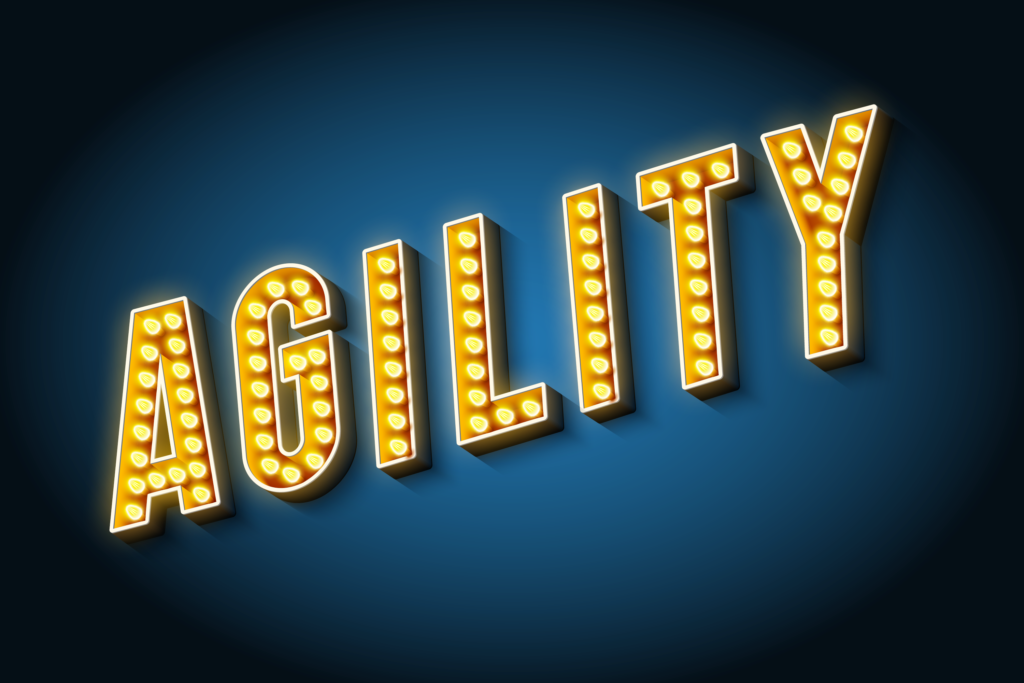
A constant for agile teams, whether on an improv stage or in a collaboration session, to get the creative juices flowing, you must follow the energy. By seeking out what is most compelling and engaging, we often find our greatest successes.
The Key to Mental Agility
An improv troupe, mid-performance, is not relying on their quick-wit alone. By exploring how the performers cultivate their ability, we can begin to understand how to be more effective in our work and better at finding new solutions to problems.
The mental agility of an improv troupe is more than just quickness of mind. A person who is mentally agile is able to think on their feet, solve problems, and be creative in the ways they engage at work. For most of us, cultivating mental agility in the workplace is not about getting a standing ovation from a heartily entertained audience (wouldn’t that be nice). Mental agility allows leaders to be more effective, and it helps teams collectively brainstorm better solutions and, ultimately, organizations to achieve more on the whole.
Appreciative Inquiry and Mental Agility
Appreciative Inquiry (Cooperrider, D., & Whitney, D, 2000) is based on the principle that in every human system, something works. When we  intentionally tap into the energy of what is working, we will likely tap into what people care about and their generative capacity to create positive futures. Just as plants grow toward the sunlight so, too, do human systems grow toward their generative and energizing core.
intentionally tap into the energy of what is working, we will likely tap into what people care about and their generative capacity to create positive futures. Just as plants grow toward the sunlight so, too, do human systems grow toward their generative and energizing core.
An appreciative focus does not mean that we ignore obvious problems, or put on rose-colored glasses that only reveal the positive. It means that we use the generative energy of what drives us to co-create new and better possibilities. In an improvised scene, players foster generativity by the practice of saying, “Yes, and . . .” They accept their fellow players’ and the audience’s ideas (or “offers”) and build on them with something that heightens and explores what is most interesting and energizing. The most compelling offers are usually those that are novel and spark their curiosity.
In creative collaboration and agile teams in the workplace, “players” similarly come together to generate new possibilities by building on each idea, rather than searching for every conceivable flaw. In organizational systems, it means following the people, processes, and products that are generating most interest and attention, as well as revenue.
Four Ways to Cultivate Your Mental Agility
Notice the (and Your) Energy
The first step to tapping the positive energy available in any situation, collaboration, team, or even organization is to notice it. Pay attention to the situations where you feel most engaged and energized. Notice the interactions and people who elevate your thinking and bring out your best, and those that you find draining and deflating. Researchers have mapped energy hubs in organizations and have found that not only are the people who energize others more productive at work, the people who work with them are also more productive, as are the people who work with those people (Cross, R., & Parker, A., 2004)! While you may not be able to spend all of your time in or with the energy hubs, you can become more aware of them and, better yet, become one yourself!

Make the Mindset Shift
I have written extensively about the importance of developing an agile mindset for overall agile success. The reason I keep repeating myself and sharing new strategies for making the shift is two-fold: 1) It is not easy, and 2) It requires repeated intentional practice. We are all wired to retreat back to our comfort zones, even after successfully finding our way through a disruption, crisis, or even unexpected opportunity. As exhilarating as these experiences are, we eventually drift back to familiar routines. This wouldn’t be a problem if we did not also drift back to a routine mindset that was not on the lookout for unexpected challenges and opportunities, and new learning. To ensure that you stay in an agile mindset as much as possible, make time to share your agility success experiences and lessons learned with your colleagues. How did you cultivate and maintain the frame of mind necessary to adapt to the unexpected quickly? How did, or do you, foster continuous learning? What could you have done differently to be even more agile and effective? Sharing your lessons learned has an added benefit: it helps build a culture of continuous learning, which is essential to agile success.
Learn to Improvise
Quite possibly you have attended a live improv show, or even taken an improv workshop at some time in your life. Improvisers are masters of responding to the unexpected and unplanned. Their mastery doesn’t happen by accident. Before they even step on stage, they have taken the time to get in the mindset and practice the skills they need to accept whatever the audience suggests or their fellow players add to the scene and build on it. What better way to develop critical skills you need to access when the stakes are high at work than in a playful improv class? You will have no trouble finding one in your area with a few clicks of your mouse!
Let Go of What is No Longer Working
The art of letting go also means not laboring over relationships and projects that simply are not coming to life, or life-giving. I regularly have opportunities to relearn this lesson, and each time I have discovered that when I move on from a situation that is no longer generative, it frees up additional energy and resources for even more fruitful possibilities.
For more ideas on improving your and your team’s Mental Agility visit: https://pamela-meyer.com/meyer-agile-innovation/
References
Cooperrider, D., & Whitney, D. (2000). A positive revolution in change: Appreciative inquiry. In D. L. S. Cooperrider, Jr., Peter F.; Whitney, Diana; Yaeger, Therese (Ed.), Appreciative inquiry (pp. 3-27). Champaign, IL: Stipes.
Cross, R., & Parker, A. (2004). The hidden power of social networks: Understanding how work really gets done in organizations. Cambridge: Harvard Business School.
